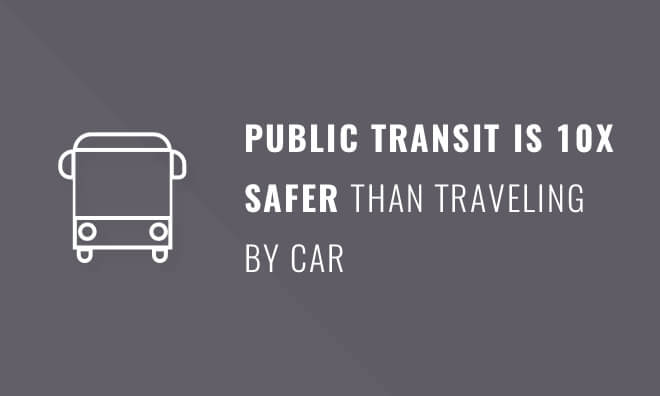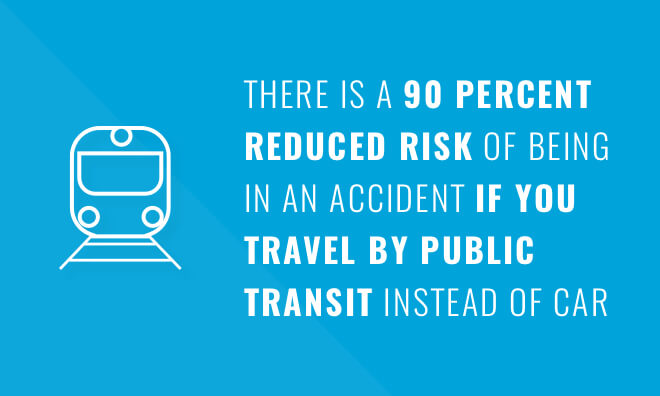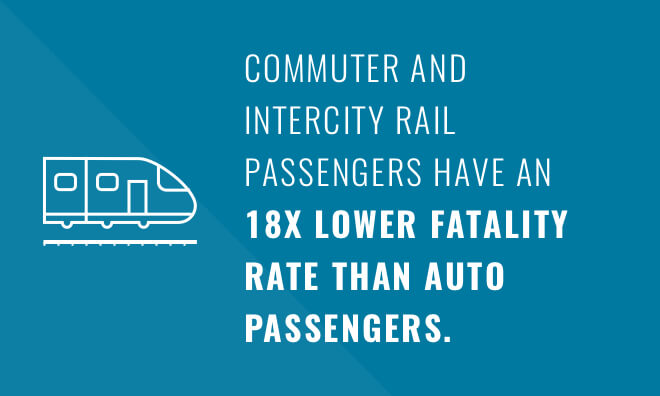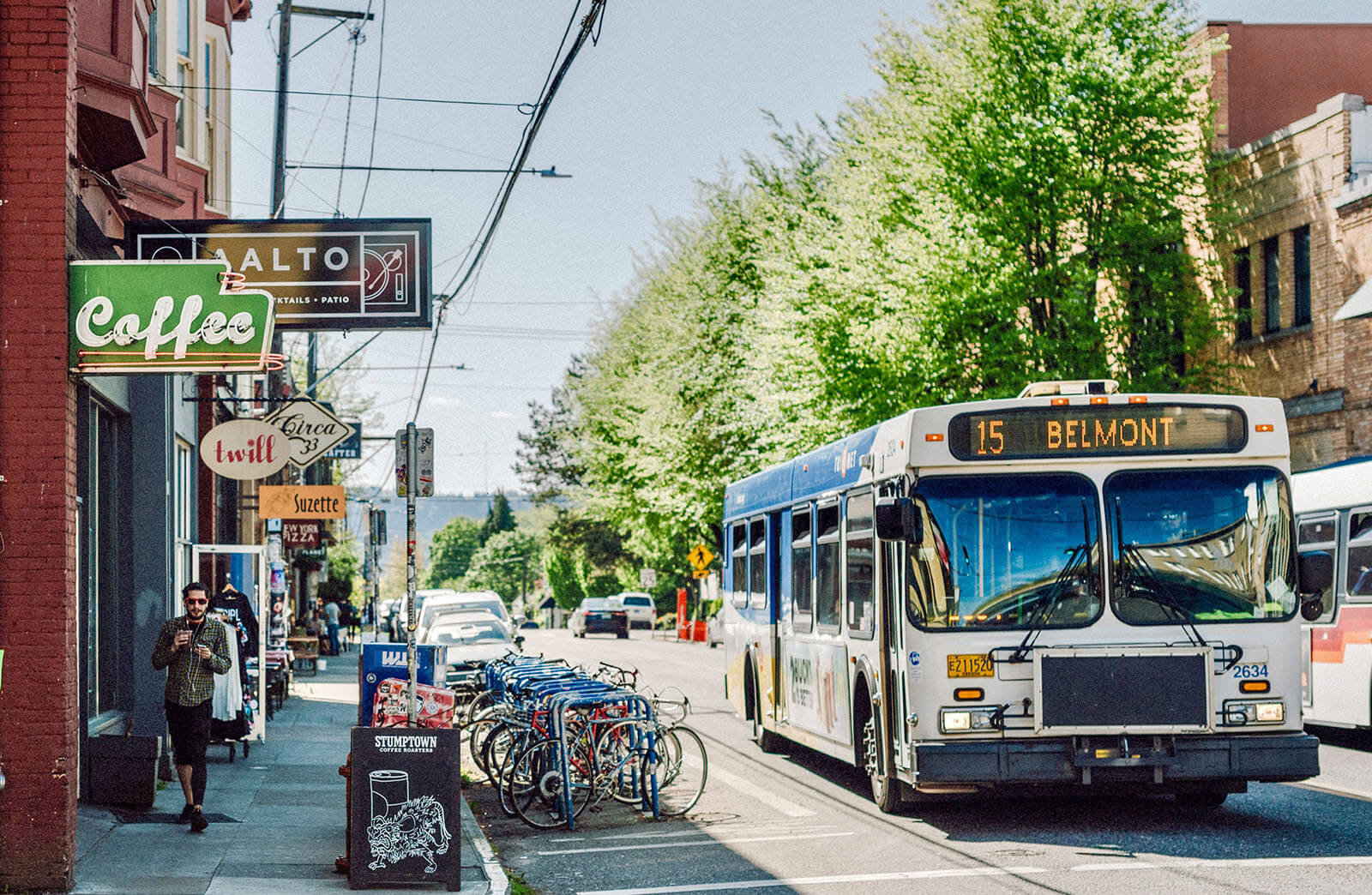Cities with Higher Public
One of the most powerful traffic safety tools a city can employ to eliminate deaths and injuries due to road traffic crashes is its public transit system. It takes just a modest increase in public transit use to result in a dramatic decrease in traffic fatalities.
The problem of traffic deaths due to automobile and light truck crashes has been well documented. According to the latest data on tracking road traffic deaths, the National Highway Traffic Safety Administration, (NHTSA) reports that there were 37,113 deaths in 2017.
Furthermore, NHTSA’s data show that the economic toll of road traffic deaths and injuries cost the nation $871 billion per year.
How much safer is riding public transit than traveling by car?






As we look toward solutions, an analysis recently released by the American Public Transportation and the Vision Zero Network shows that public transportation is an effective, and we believe, essential, solution to helping cities move toward the goal of zero deaths and injuries on our roadways.
Let’s first discuss the impact that a strong public transit system can have on cities’ roadway traffic safety. Metro areas that invest in public transportation — such as heavy rail, light rail, frequent bus service and commuter rail — can cut their traffic fatality rate by half.
Public transit is a key strategy in advancing vision zero and eliminating traffic fatalities
Specifically, metro areas with higher public transit use — more than 40 annual transit trips per person — have half the traffic fatality rates of areas with fewer than 20 annual transit trips per person. When a metro area increases the annual number of transit trips per person from 20 trips to 40, it translates to people taking just two additional public transit trips per month. Yet this relatively small percentage change in ridership provides a disproportionally larger traffic safety benefit.
Simply put, a small increase in public transit use can result in a dramatic decrease in traffic fatalities. A city with a strong public transit system creates a safer environment for our cities — garnering these great safety benefits is something we can do; and we can do it today.
Now, let’s look at the traffic safety impacts that a robust public transportation system can have on individual travel. This analysis shows that for individuals, public transportation is 10 times safer per mile than traveling by car, with less than a tenth the per-mile death rate as compared to automobile travel.
Every day, 100 people die due to traffic crashes on America’s roads, and increasingly communities are committing to Vision Zero because they believe that everyone deserves to be safe on our streets. Investing in strong public transit systems helps communities improve safety for everyone on the roads.
Leah Shahum
Founder and Director of the Vision Zero Network
At the NTSB, we investigate transportation disasters of all types, but by far, more Americans die on our roads than in any other mode. Public transportation is an important safety tool…I am pleased to learn about this APTA and Vision Zero Network partnership and report which I hope will help all of us put safety first in our communities and our nation, no matter what form of transportation we choose.
Bella Dinh-Zarr, PhD,
board Member, the National Transportation Safety Board (NTSB)
Subways, buses and trains are the safest modes of transportation and serve to make the roadways in transit-rich cities like New York among the safest in the country. As New York continues to improve and expand our mass transit systems, we are also aggressively working towards the goals of Vision Zero: eliminating all fatalities and serious injuries on our roadways.
Commissioner Polly Trottenberg
The New York City Department of Transportation, and the Metropolitan Transportation Authority Board Member
Vision Zero starts with the premise that traffic fatalities are both avoidable and unacceptable and that even one fatality is too many. In San Francisco, we are redesigning our streets to achieve the dual benefit of safety for all road users and increased transit reliability, in support of our goals to eliminate traffic fatalities while increasing public transit ridership and mode share.
Edward D. Reiskin,
director of Transportation of the San Francisco Municipal Transportation Agency (SFMTA)
Shifting trips onto public transit creates safer, healthier, and more vibrant communities. Creating less conflict among modes and building the infrastructure to support it is fundamental to Vision Zero's success. Giving dedicated access to transit vehicles is a major step in improving transit movement and keeping other modes safe.
Monica Tibbits-Nutt,
board Member of the Massachusetts Bay Transportation Authority
Public transit modes that serve longer trips can help reduce vehicle miles traveled, as well as provide significant safety benefits to users. For instance, traveling by commuter and intercity rail is 18 times safer for passengers than traveling by auto. This is because commuter and intercity rail passengers have one-eighteenth the fatality risk as people traveling by auto.
Equally as significant, a city’s public transit system provides a safe alternative for high-risk and vulnerable road users. It is important for senior mobility, and it takes inexperienced teen, distracted and drunk drivers off the roads.
Safety of all road users dramatically improves when elected city leaders, developers and planners utilize public transit to create compact development, also known as transit-oriented development, which provides for lower and safer traffic speeds.
Public transit even benefits people who do not use it and are otherwise safe drivers, because it helps reduce the risk of being the victim of other drivers’ mistakes. It is essential our elected leaders on all levels continue to provide support and strong investments in public transportation because of transit’s extensive traffic safety benefits.

APTA and the Vision Zero Network are partnering to encourage increased collaboration among city leaders, public transit and traffic safety professionals.
Given that traditional traffic safety programs generally overlook public transportation as a potential safety strategy, the new and transformative approach of Vision Zero offers a prime opportunity to promote and expand the use of public transportation as a proven effective tool to help move our communities toward zero deaths and injuries on our roadways.
It is our hope that city leaders, transit and traffic safety professionals, as well as advocates, will use this analysis among other traffic safety tools as they leverage their local public transit systems to help save lives and reduce injuries on America’s streets.
